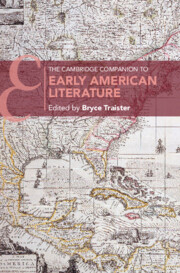Book contents
- The Cambridge Companion to Early American Literature
- The Cambridge Companion to Early American Literature
- Copyright page
- Contents
- Figures
- Contributors
- Introduction
- Part I How to Read (in) Early America
- 1 How to Read Things That Weren’t Written Down in Early America
- 2 How to Read the Natural World
- 3 How to Read Early American Poetry
- 4 How to Read Gender in Early America
- 5 How to Read an Early American Novel
- 6 How to Read Democracy in the Early United States
- Part II Readings in Early America
- Part III Early American Places
- Select Bibliography
- Index
- Cambridge Companions To …
6 - How to Read Democracy in the Early United States
from Part I - How to Read (in) Early America
Published online by Cambridge University Press: 18 November 2021
- The Cambridge Companion to Early American Literature
- The Cambridge Companion to Early American Literature
- Copyright page
- Contents
- Figures
- Contributors
- Introduction
- Part I How to Read (in) Early America
- 1 How to Read Things That Weren’t Written Down in Early America
- 2 How to Read the Natural World
- 3 How to Read Early American Poetry
- 4 How to Read Gender in Early America
- 5 How to Read an Early American Novel
- 6 How to Read Democracy in the Early United States
- Part II Readings in Early America
- Part III Early American Places
- Select Bibliography
- Index
- Cambridge Companions To …
Summary
Americans know the story of democracy: how the Framers built a government with branches that would check and balance, that would derive its authority from sovereign citizens, filtered and refined by their elected representatives. Americans may refer to our system as “democracy” but the representative republican framework provided by the Framers ensured the safe democratization of our country over time. This well-rehearsed story frames American democracy as a bequest from the Framers. Yet this powerful founding story is a victor’s tale, designed to erase from collective historical memory a very real battle with a robust alternative model of democratic theory and practice that was flourishing – much to the Framers’ consternation – in the early nation. This alternative democracy originated in the daily practices of ordinary colonists. Their vernacular democracy generated and motored revolution; and though the political elite embraced this participatory and equalitarian practice, they later pulled away, seeking in their words to “tame” the democratic enthusiasm and power of ordinary American citizens even as they drew on that power (renamed “sovereignty”) to authorize the representative federal republicanism they offered as a containment device. Knowing about vernacular democracy enables readers to see its record in the literature of the early United States.
Keywords
- Type
- Chapter
- Information
- The Cambridge Companion to Early American Literature , pp. 97 - 114Publisher: Cambridge University PressPrint publication year: 2021



